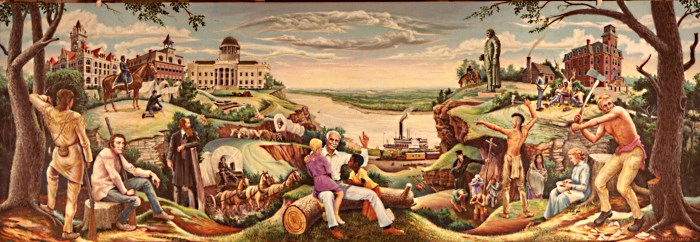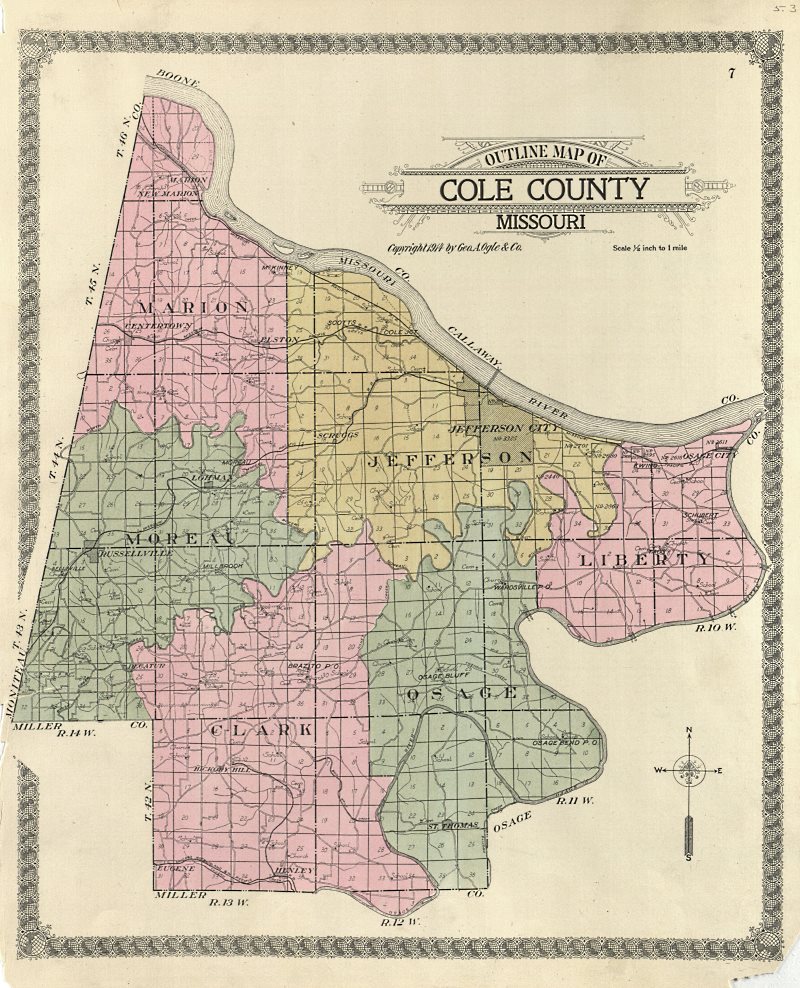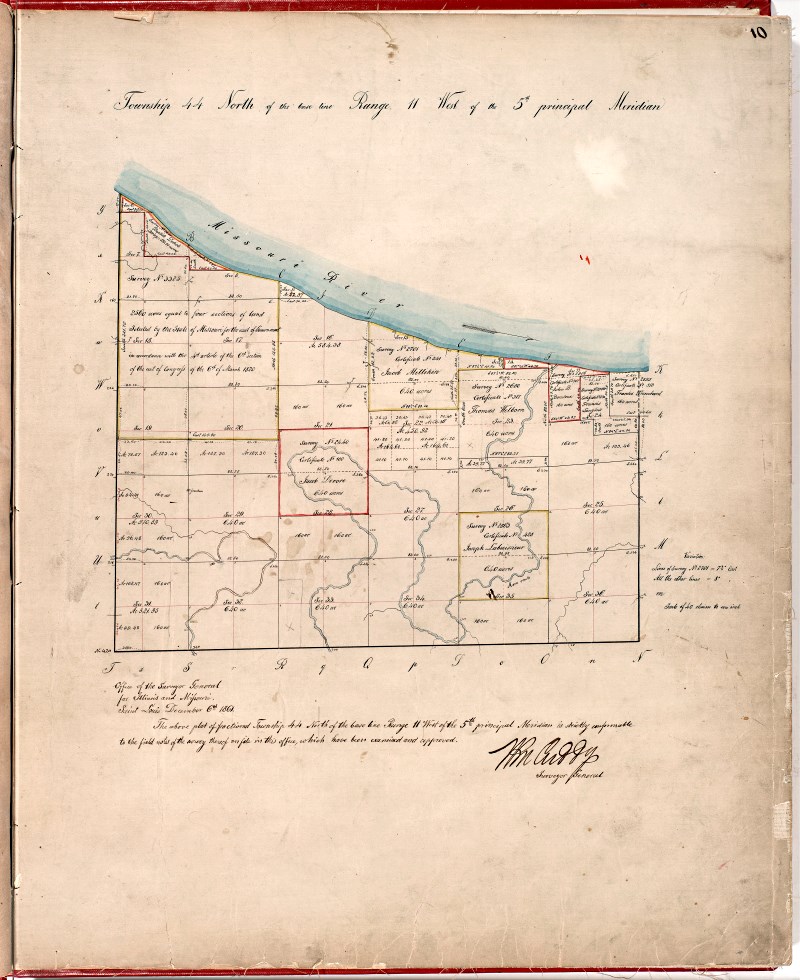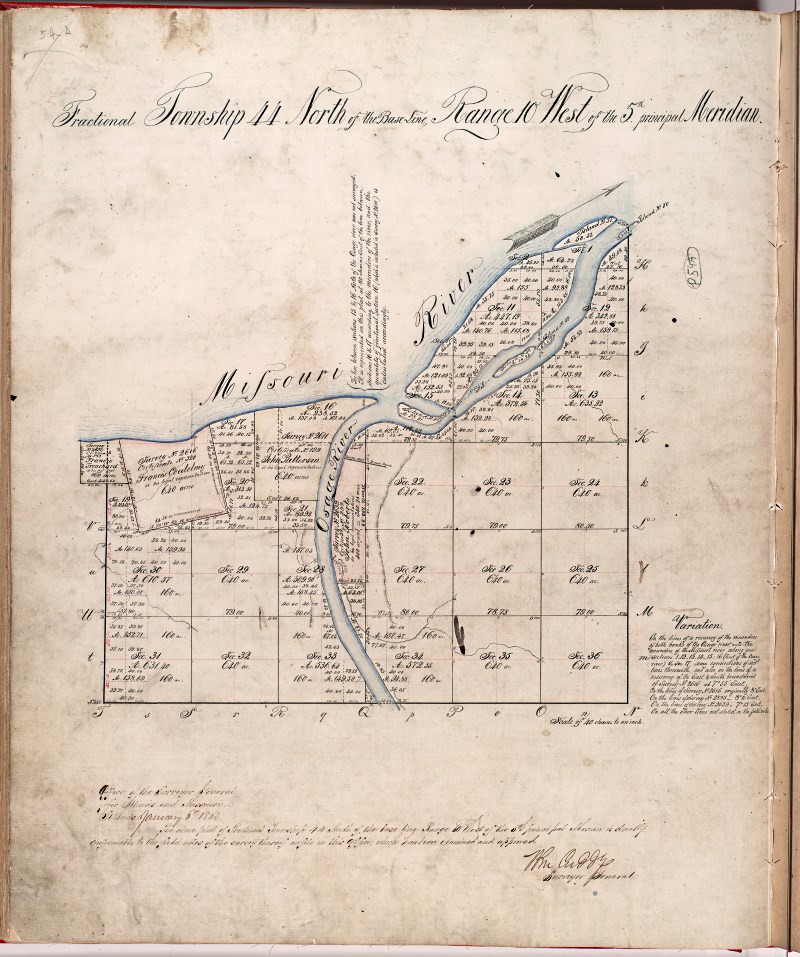
|
 |
Historic Cole County |
Historic Cole County
On July 13, 1818, a 160 acre tract of land in Section 18, Township 44N, Range 02W was the first sale of land by patent purchase in east-central Missouri. The land office holding public sales, worked their way westward until the first patent sale of land in the soon to be counties of Callaway and Cole, which occurred on December 16, 1818. In the ensuing month, names such as: Hall, Cole and Cox were among the first purchasers of land in Callaway County. It wasn't until February 1819 that the first significant numbers of land purchases in Callaway and Cole Counties began, with the names of purchasers which include: Shobe, King, Ewing, Young, Moore, Guthrie, Brooks, Nevins, Hall, Smith, Vance, Ramsey, Ferguson, J.S. Ferguson, Flood, Litton, Langley, Craighead, Hockaday, Allen, Bryan, Coshaw, Barry and Beatty, all flooding in for land purchases between February 05 and February 10, 1819. Sales of land in these counties continued for some time at a greatly reduced pace; but included many very recognizable names from the early history of the counties.
The following map presents the full fractional township in which the four full sections of land were granted to Missouri for Permanent Seat of Government
Land Acquisition by New Madrid Certificates and Patents
Original Landowners (Assignees) of New Madrid Grants
Cert # Twn Rng Surv # Grantee Assignee Date Redeemed County
100 44N 11W 2440 Jacob Devore Easton, Gamble & Smith April 11, 1826 Cole
270 44N 11W 2596 Francis Langolis Langolis & Chrisman March 14, 1821 Cole
347 44N 11W 2681 Baptiste Delisle Hempstead & Langham June 02, 1821 Cole
341 44N 11W 2701 Jacob Millikin Miller, Pendleton & Rector January 07, 1822 Cole
428 44N 11W 2863 Joseph Labuissieur Langham & Berry April 23, 1823 Cole
507 44N 11W 2906 John B. Barseloux Patrick M. & George Dillon February 01, 1821 Cole
513 44N 10W 2895 Francis Trenchard Jonathan Ramsey February 23, 1819 Cole
History of Cole County Goodspeed
Historic Maps of Cole County
|
Land Acquisition by New Madrid Certificates and Patents
Original Landowners (Assignees) of New Madrid Grants
Cert # Twn Rng Surv # Grantee Assignee Date Redeemed County
199 44N 10W 2611 John Patterson W. Rector & A. Langham June 30, 1817 Cole
320 44N 10W 2616 Francis Contelmy Miller Rector & Langham July 06, 1817 Cole
513 44N 10W 2895 Francis Trenchard Jonathan Ramsey February 23, 1819 Cole
Historic Maps of Callaway County
History of Cole CountyTRANSACTIONS OF THE COUNTY COURT.County Formation.- All that part of Cooper County beginning on the Missouri River at line between Ranges 14 and 15; thence in the southwesterly direction to the corner of Townships 46 and 46, Ranges 15 and 16; thence south with said range line to the main channel of the Osage River; thence down the middle of that river to the middle of the main channel of the Missouri River; thence up the Missouri River in the middle to a point due north of the place of beginning; thence south to the place of beginning. In the following pages, devoted to the transactions of the county court from 1821 to 1861, much of all that is valuable and instructive in the history of this section is contained. Court Proceedings.- The same month, elections were ordered to be held in the several townships, that in Moreau at Gilbert Cottrell's house, where Francis Hensley formerly lived, with James Claybrook, Drury Davis and James Moad, judges. In August, 1822, Jonathan P. Martin, surveyor, was instructed to meet the surveyor of Cooper County, on the line between the counties on the Missouri River, and run a line southwest to the corner of Townships 4-5 and 46, Ranges 15 and 16. George F. Pettigrew and Isaiah Stephens, justices of the peace, reported on laying off roads in Moniteau. Jesse F. Royston was appointed a justice in Moreau, and Richard Miller's house at Marion was established as the Beat of justice. William Allen was appointed collector, and Richard Miller, commissioner of county buildings, vice James Miller, deceased. In February, 1823, Marion Township was divided, the north half retaining the name and the South half to be named Moreau, of which John Morgan was appointed constable. A road from Jefferson was authorized, the petition bearing the signatures of John Brown, Joel Melton, Rich. Lundy, John Wyatt, John Stewart, John Stuart, William Stuart, John C. Gordon and Andrew Reed. On May 26, 1823, the court-house and jail commissioners reported that James H. Hayter had completed the jail, and he was paid $690. They also reported the sale of several lots to John Inglish, J. H. Hayter, Henry Tucker, Jonathan P. Martin, James Inglish and others. In 1823 Jesse F. Royston was commissioned county judge by the governor, and William Wade succeeded James Moad as commissioner of buildings. At this time William Taylor was granted $59 for nursing, clothing, etc, the first ward of the county, a child named Marion Cole. The township of Jefferson was established in November, 1823, with the place of meeting at Dan Colgan's house. In January, 1824, ft transcript of the administration of the estate of Philip Johnson, who died in 1820, was made by his widow Margaret, and in February the administration of the James Miller estate was considered. The old eagle seal was adopted Joseph Inglish reported the building of the " stray pin " complete, and was granted $19. John Routon was nominated justice for Moniteau, vice Joseph Inglish, and John C. Gardner and William Jones for Jefferson City. The superintendents of buildings reported that in February, 1824, they sold Lots Nos. 1, 22, 23,24, 30, 29, 26,28, 27 and 25, in the town of Marion, for $44.12 1/2 in loan office certificates or auditor's warrants. This sum, with the proceeds of former sales, amounted to $1,653.81. Out of this the money for building the jail was paid. James Regan and William Newman were appointed school land commissioners for Marion Township. Patrols were appointed for Moniteau and Jefferson. The amount of tax list reported by Collector John Alien in November was $156.14, of which the sum of $116.07 3/4 was expended. At this time Thomas Smith and John Hunter were appointed superintendents of buildings. In March, 1825, the act to establish courts of justice and ascribe their powers came into force. Among the justices of the peace who took their seats at this term were Hugh Gartner, William Wade, Mr. Johnston, John C. Gordon, William Newman, James Maupin, John Scruggs, William Walker and John Hunter; Jesse F. Royston presided in July, 1825, Jason Harrison was recommended for probate judge, vice Robert A. Ewing, resigned. In August a petition was presented by Daniel M. Boone, signed by residents of Jefferson Township, asking that a road from Jefferson City to Barton's Ford be established. Jonathan P. Martin was sheriff, vice Paul Whitley; Harrison was still clerk, and Joe Inglish, collector. In November George Woodward became one of the justices, Jeremiah Meadows, Joseph Skidmore and Richard Lundy were appointed to lay out a road leading from Jefferson City, and the city was incorporated, as shown in her history. Patrols were appointed for Jefferson Township. James English, David Ca. (record eaten by worms) and Boyd Miller were commissioners to locate a road from the salt works to Jefferson City; William Wade was appointed county treasurer, and John D. Williams contracted to do some work on the courthouse for $6.75. Dunnica, Woodward and Langan were appointed judges of election for Jefferson Township; James Fulkerson, John Hensley and Thomas Smith for Marion; Benjamin Stark, Benj. Amos and Drury Davis for Moreau; Isaac Eads, Isaiah Vivion and John Mulkey for Moniteau. The commissioners of school lands then appointed were J. F. Royston, David Coulter and John Scruggs for Jefferson; James Fulkerson, John Hensley and one other for Marion; William Newman, D. Davis and a third for Moreau. [The recorded names of the other townships were destroyed. J In the fall of 1825 the courthouse at Marion was partially completed, and in August the contract for putting in brick floors, together with doors and windows, was sold to Paul Whitley for $75, which brought the total cost of building up to $748. William Wade resigned the office of treasurer in February, 1826, when Mr. Royston was appointed. Jonathan P. Martin was chosen assessor and Dan Colgan constable of Jefferson Township. Thomas Murray was licensed to run a ferry on Moniteau Creek at Canoe Landing. In May the county was districted for road purposes, and the boundaries of the townships re-defined. Josiah Ramsay was licensed to keep a tavern at Jefferson City in February, 1827. Daniel McKenzie and James Stark qualified in May as judges of the court, with James Dunnica the former system of representation by justices of the peace having been abolished. In June Tabash Murray was granted license to keep tavern at Marion, and in November he was appointed constable. In February, 1828, Joseph Inglish was appointed to select school lands, under the act of January 27. Jones and Drury and Daniel Colgan were licensed to keep tavern at Jefferson City, and Jason Harrison at Marion. Roads from Dr. S. Crow's house and from Howard's Mill to Jefferson. City were changed in May. Lisbon Applegate was appointed deputy surveyor, and in November took his seat as a judge of the court, vice McKenzie. The last meeting at Marion was held February 8, 1829, and the first meeting at Jefferson City at John. O. Gordon's house, March 80, 1829, under the act of January 21, that year, removing the county seat. The commissioners under the act were Samuel Crow, John Scruggs and Martin D. Noland. After receiving the report of the commissioners, the judges granted a tavern license to Job Goodall, the fee being $10, to keep tavern at Jefferson; also one to Robert H. Jones, one to William Herndon, one to Daniel McKenzie and one to Josiah Ramsay, Jr. In May the subscriptions obtained by commissioners for the removal of county seat, together with amount which might be realized from sale of old court-house, the moneys due by Mariah Kennedy and R. Lundy, with license and merchandise fees, about $900, were appropriated toward building a jail on Lot 847 in the new city. Adam Vivion was appointed county collector in June; Stephen C. Dorris took his place as county judge, with James 8tark and Lisbon Applegate, of the former court John D. Williams was sheriff, and Jason Harrison still clerk, with Hiram D. Baber, deputy. Alfred M. Houston was recommended as justice of the peace for the new township of Clark, with George Greenaway, and the court ordered the attorney-general to commence suit against the commissioners of the old county seat, Richard Lundy and Azariah Kennedy, on their bonds; but in January, 1880, this order was quashed. Walker Township was established in January, and John Perkins was appointed constable. John Allen, Reuben Jobe and Peter Sailing were appointed judges of election, which was ordered to be held at John Walker's house. In February the court granted ?20 to John C. Gordon, as rent for his house from February, 1829. In May a number of deeds to lots in Marion were acknowledged by the commissioners: Sixteen to. Hutchings Inglish, five to Daniel McKenzie, five to Joshua Chambers, twenty-four to Ezekial V. Hollingsworth and eleven to Jason Harrison. Martin D. Noland was collector at this time, vice Martin. In February, 1881, John D. Williams, the sheriff, qualified as assessor; a room was rented from John C. Gordon, at $18 per annum, to be used as the clerk's office, while the House granted the use of Representatives' Hall to the county and circuit courts. In May a wooden bridge on stone pillars was authorized to be built over Moniteau Creek, on the Jefferson and Boonville road. Almon Inglish qualified as collector in June, and Jesse Applegate as county agent for the sale of school lands. Messrs. Stark, Applegate and Dunnica formed the court. In August, 1831, a bridge across Swing's Creek at Jefferson City, on the Marion road, where an old bridge once stood, was authorized, and James Dunnica appointed commissioner. In February, 1832, Collector Inglish settled with the county, paying $17.75 in cash and $3 in six wolf scalps. Reuben B. Overton was licensed in March to keep tavern at Jefferson City on payment of $10. In May Thomas Plemmons qualified as county judge; Cato, a colored freeman, was licensed to keep a ferry at Marion, and James M Fulkerson one on Moniteau Creek. In June Robert H. Jones qualified as collector, David Coulter being sheriff. At this time the court agreed to rent from R. W. Wells the old post office at $50 per annum, and ordered the same to be used after July 1, 1832, for county and circuit court purposes. In 1833 Israel B. Reed [or Read] was treasurer. Saline Township was established May 7, with the place of meeting at William Brockman's house, and Alfred M. Houston recommended for justice of the peace. Elias Barcroft was appointed commissioner of school lands, rice Jesse Applegate. The question of repairing the jail, opening new roads, building bridges and administering estates occupied the attention of the court during the latter days of 1883, and the old, venerable, worm-eaten record book beginning in 1821 closes under date December 3, 1833. Record B opens under date In July, 1841, a statement of all moneys since November, 1839, was prepared, showing the balance due on account of court house, $7,022.89; balance due on account of warrants issued for general expenditures, $6,202.14 (the whole amount being $11,861.02); due School Township 44, Range 11, $3,157.79, and Township 44, Range 18, $540.50, or $8,700.29. The total indebtedness in July, 1841, was $16,926.32, but of this sum J. P Martin owed $807.49 on account of licenses; buyers of old jail lots owed $929.60, and William N. Melton, former sheriff, owed $991.92, and other sums amounting to $16.27, leaving net debt, $13,940.79. The amount of school land sales was $6,021.64, and the total deficit in all the school townships, $2,499. On May 11, 1842, the balance outstanding was $8,786. In 1848 G. A. Parsons is mentioned as clerk; in June the sheriff's office was declared vacant, owing to Jonathan P. Martin failing to give bonds. Robert W. Gray was one of the judges. In June of this year County Clerk Parsons was ordered to procure iron for lightning rods, and have them placed on the court-house, while Rev. Dr. Goodrich, James Dunnica, William M.Kerr, John Curray, Reuben Garnett, Jason Harrison, Alfred Basye and Hampton Boone were appointed a committee to take special care of the court-house in consideration of it being granted for the use of religious worship. The financial statement made May 2, 1844, shows $9,685.85 due by county in May, 1843, and $4,822.17 warrants issued prior to May 2. 1844. Of the total sum, $6,579.84 was paid in 1843-44, leaving a balance against the county of $7,939.28. In February, 1845, Robert Moore took Judge Gray's place; but in May following Alexander Irvine presided, with Robert A. Ewing and Whitley Fowler, associate judges; G. A. Parsons, clerk; William D. Kerr, sheriff, and M. M. Parsons, public administrator. This board instructed the county surveyor to meet the surveyor of the new county of Moniteau at the southwest corner of Section 32, Township 43, Range 14, and run the dividing line between that and Cole County. During the year ending May 1,1845, the warrants outstanding reached the sum of $15,160.97; while of this no less than $10,665.56 was paid off, leaving the indebtedness $4,491.51; but this amount was increased to $9,017.88 before May 1, 1847, reduced, however, to $8,520.49 in May, 1848. In August, 1847, Presiding Judge Ewing and Judge W. Fowler canvassed the vote for county and circuit clerk, and declared G. A. Parsons elected for six years. Russell W. Murray was elected surveyor. Liberty Township was established in March, 1848, being detached from Jefferson, and the elections ordered to be held at Henry Keisling's house. In August, 1848, 'Squire Wade was elected assessor; but the election was contested by Erich Plump, who was declared the assessor by the court William M. Kerr was elected judge vice Alexander Irvine-Judges Ewing and Fowler holding over, and M. L. Jefferson sheriff vice Kerr. In August, 1849, resolutions on the death of Presley T. Cordell, a member of the bar, were entered on the county court records, although adopted at a meeting over which Gen. li. L. Edwards presided. The amount of warrants outstanding May 1, 1849, was $8,446.08, and in November Henry Clay Ewing and Ephraim S. Ewing were appointed deputy clerks. In May, 1850, William B. Stark was granted $100 for making a chart of taxable land in Cole County never hitherto noticed. The total amount of warrants outstanding in May, 1850, was $13,820.81, and the total amount due the several school townships was $22,621.68. In November of this year John W. Wells took Judge Fowler's place, otherwise the officers of the court were unchanged. The warrants outstanding in May, 1851, amounted to $10,133.84, while $23,964.95 was due the school townships. In November, 1852, Levi Gunsaullus appeared as sheriff vice M. L. Jefferson, and in May, 1868, H. Clay Ewing qualified as public administrator. In 1864 Osage Township is named on the records, and in July, 1855, it was divided into four road districts, with D. D. Bolton, W. T. Shaw, Charles Frisch and Henry Yearlin overseers. In February, 1866, the coroner was instructed to summon Levi Gunsaullus and Mb bondsmen to show cause why judgment should not be entered against them for the taxes of 1855. In May, 1856, James M. Wiley was appointed coroner, vice William D. Pratt, who failed to qualify, and he was ordered to bring Gunsaullus and his securities before the court to account for the taxes of 1855. In 1856 Robert A. Ewing was chosen judge of the county court for six years, W. F. Fowler for four years, and William C. "Young for two years; William D. Kerr, sheriff and collector, and C. P. Anderson, coroner. On Judge Young resigning, Enos B. Cordell was commissioned. In February, 1857, the sheriff returned the execution against Gunsaullus and his securities for $7,706.63, less $600 credited. The financial statement of the county in May, 1867, showed it to be $8,368.98 in debt, with $6,317.20 of the taxes of 1854-55-56, outstanding. Judge Ewing's death took place in December, when William C. Young was commissioned. About this time the rooms on the first floor of the court-house were plastered, and new furniture and office fixtures introduced The assessors of the four districts in 1857-68 were Peter Dirch, J. W. Moore, John C. Russell and James C. Short, and commissioner of schools, Paul C. Edmunds. In November, 1859, Theo. Stanley with Judges Fowler and Young formed the court, with W. W. Bolton, sheriff, G. A Parsons, clerk, and J. R. McCurd, deputy clerk. In February, 1861, the court ordered that the use of county buildings be denied the United States District Court until provision be made for the payment of rent At this time P. P. McNeil was superintendent of the County Poor House. In February, 1862, T. M Winston took the place of sheriff and the collector, Bolton, resigned. In November, 1862, the treasurer, C. Wagner, was ordered to sell $400 in gold at 28 1/2 cents premium, and silver at 16 per cent, equaling $147.97 on the $542 in the treasury. In 1863 Herman L. Bruns took Sheriff Winston's place as sheriff and collector; S. H. Legg was judge, vice W. C. Young. In August, 1864, the use of the circuit court room was granted to the United States for the purposes of holding United States district courts, at the yearly rent of $200. Thomas B. Wallace, United States Marshal, signed the agreement In October, 1888, one hundred dollar oounty warrants were issued to United States volunteers from this county, and John Opel ordered to distribute them. H. W. Long was assessor in 1865, and in March of that year Anton Moeller, contractor for covering the court-house, was paid $1,200. Alfred Gensel was employed as county attorney at $200 per annum. S. H. Legg, Philip Ott and J. F. McKernan formed the court; the coroner, Charles L. Wells, acted as sheriff until H. L. Bruns qualified, with William H. Lusk, clerk. The appointment of Thomas R. Edwards and Julius Conrath, deputy clerks, was confirmed. Josiah R. Lamkin was appointed sheriff in September, 1865, vice Bruns, resigned, but in November Peter Meyer was elected sheriff and collector, and J. B. Mayer was commissioned county judge, vice Ott, resigned; in February, 1866, H. H. Baber was commissioned to take Judge Mayer's place, so that after these changes Messrs Legg, McKernan and Baber formed the court In May E. P. Lamkin was appointed superintendent of schools, under the act of March 29, 1866. In December. 1866, Judges Baber, Philip Ott and F. A. Clarenback presided, with G. H. Dulle, sheriff, and W. H. Lusk, clerk; but in January, 1867, C. M. Ward qualified as clerk, vice W. H. Lusk, who was candidate for the Legislature in 1866. In the chapter devoted to elections the members of the county court and officers of the county since the war are named, while important transactions of the court find mention in the pages devoted to local history. The record books of the office are complete from 1821 to 1889, except where preyed upon by the insects which came so near destroying them some fifteen years ago. Through the courtesy of County Clerk Grimshaw and Deputy Kroeger, the compiler was enabled to make a thorough summary of the valuable books in this office. Source: History of Cole, Moniteau, Morgan, Benton, Miller, Maries, and Osage Counties, Missouri. |



